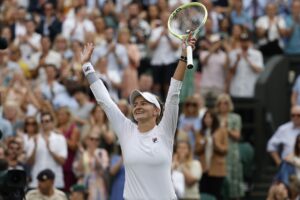Alejandro Davidovich Fokina in 2019
The future of Spanish men’s tennis does not look so bleak anymore. Expecting an irruption of another all-time superstar like Rafael Nadal was totally unrealistic, but with the majority of the stalwarts of the once mighty Armada on the wrong side of 30, fresh blood was urgently needed.
Well, the 2019 tennis season provided glimmer of hope for us Spaniards. Although the Generation of 1997 has pretty much stalled, the younger prospects are coming strong. Not from a quantitative standpoint, but quality wise.
Young talents on the rise
Injuries have finally abandoned Carlos Gimeno and the 18-year-old showed plenty of promise. In July, he reached the Wimbledon Boys final. The Valencia native then ended the season on a 11-match winning streak on the ITF World Tour, lifting two titles. Meanwhile, Juan Carlos Ferrero’s protégé, Carlos Alcaraz, collected 60 ATP points in 2019. At No. 490, he is the best ranked player from the class of 2003, with No. 837 Shintaro Mochizuki from Japan a distant second. And it would be foolish to forget about 19-year-old Nicola Kuhn (No. 214), who recently beat Alcaraz and Jaume Munar en route to the Spanish U23 unofficial crown.
While those teens still got a long road toward the Top 100, our featured player in this article is already a tangible reality. Last December, I said “the Malaga native is a year or two away from making a real impact on tour, but it would be foolish to rule him out of the race to Milan.”
Davidovich made a substantial leap in 2019
Over the past twelve months, Alejandro Davidovich rose from No. 237 to No. 87 in the ATP rankings, a massive 150 spot gain. Thus, was my prediction on point? Yes and no.
On one hand, sidestepping the 100-250 purgatory in merely a year is remarkable. Barring injury or sudden collapse, Davidovich will get main draw access to all four Grand Slams, Indian Wells and Miami, where he can earn large chunks of points with a few wins.
On the other hand, the Spaniard compiled a poor 3-7 record on the main tour (3-10 if we count the NextGen Finals), with all three victories coming at the Estoril Open. And aside from his 4-6 7-5 6-0 loss to Mikael Ymer in Bastad, where he served for the match, he was clearly inferior to his rivals.
Challenger domination behind a supreme return game
In 2019, Davidovich was a legitimate Challenger monster, posting a robust 34-11 record, including the Seville and Liuzhou crowns. Of those 11 defeats, just three came in straight sets. According to Tennis Abstract, he won an astounding 45% of his return points. For reference, Novak Djokovic won at a 44.6% clip in his unbelievable 2011 campaign, his best mark ever. Of course, the ATP level is a different animal, but Davidovich’s 38.5% rate is still very respectable.
In line with most notable Spaniards, the 20-year-old does not possess a top-flight serve. At the Challengers, he survives with a borderline 60.2% winning percentage on serve. However, a 56.3% ratio on the main tour does not cut it. Even if he has the weapons to go toe-to-toe against anybody from the baseline, Davidovich needs a better service in order to be successful in modern tennis.
Another issue he must address is his bad temper. Whenever things go awry, he often implodes. For example, in his loss to Filip Horansky, he did not bother to play the match point.
Three areas to polish up in 2020
If Alejandro Davidovich wants to establish himself as a regular in the Top 50, he needs to sort out the following issues. First, he cannot afford as many mental lapses, as margins are so thin at the top of the game. When Nick Kyrgios goes bananas, sometimes he gets bailed out by his terrific serve. Well, the Spaniard does not have this luxury.
Speaking of serve, as stated above, Davidovich and his coach Jorge Aguirre must devise a plan to win more points with it. Since he won’t develop a fierce 230km/h bomb overnight, he should try to imitate Nadal’s approach. Easier said than done, obviously, but feasible. Nadal wins so many points on serve because he is arguably the best at hitting the first shot after the return comes in. Whether it is after a wide, down-the-T or body serve, Nadal usually gets his opponent on the run hitting an uncomfortable second shot. And he pounds it over and over.
Lastly, Davidovich needs to be a bit more selective with his go-for-broke shots. I agree that the ability to hit any shot from any position is a blessing, not a flaw. Nevertheless, the goal is to win tennis matches, not to produce the most highlight reels. There is a reason why Djokovic has 15 majors and fan favorite Dustin Brown has never made it past the round of 32 of a Slam. If Alejandro Davidovich is able to blend his shotmaking skills with more conservative patterns, watch out!





